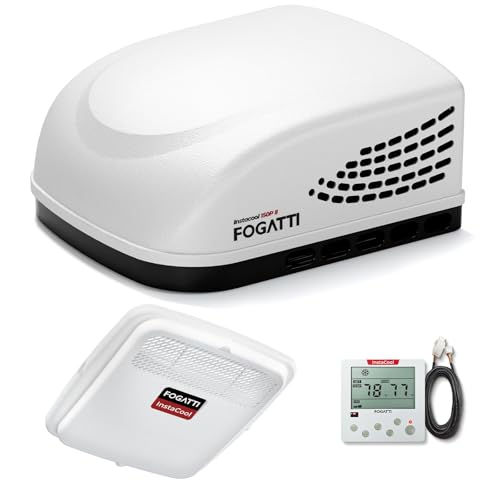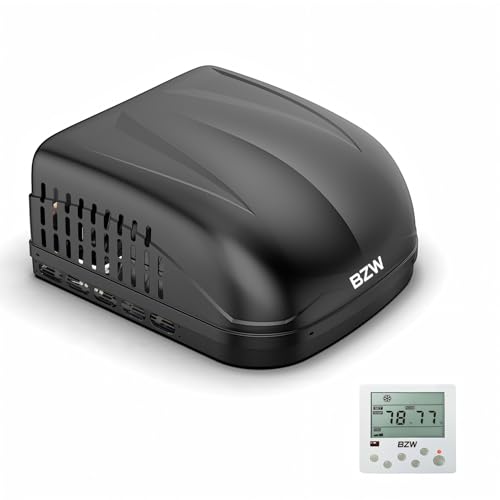Finding an RV air conditioner with heating capability helps extend your travel season and improves comfort in changing climates. Below is a comparison table of five top rooftop units chosen for their cooling power, heating methods, efficiency, and road-ready construction.
| Product | Cooling | Heating | Power Type | Notable Feature |
|---|---|---|---|---|
| RecPro RV Air Conditioner 15K | 15,000 BTU | Heat Pump | 110–120V | Low Amp Draw, Quiet |
| TOSOT GO Cool 15000 BTU | 15,000 BTU | 12,000 BTU Heat Pump | 110–120V | WiFi Control, Wide Temp Range |
| FOGATTI InstaCool 15000 BTU | 15,000 BTU | 1500W Heat Strip | 115V | Dual Compressors, R32 |
| TURBRO Inverter 13.5K BTU | 13,500 BTU | Heat Pump | 110–120V (Inverter) | Inverter Compressor, Slim Profile |
| BZW RV Air Conditioner 15000 BTU | 15,000 BTU | 12,500 BTU Heat Pump | 110–120V | 4-Season Heat Pump, Low Amp Draw |
Content Navigation
RecPro RV Air Conditioner 15K Ducted Or Non-Ducted

Cooling And Heating Capability: Offers 15,000 BTU cooling and integrated heat pump operation suitable for year-round use in many RV sizes.
Energy Efficiency: Designed with a low amp draw so you can run multiple RV appliances without tripping circuits—useful for solar, generator, or limited electrical systems.
Noise And Durability: Advertised whisper-quiet 55.4 dB operation and UV-resistant, aerodynamic housing built for road use. Quiet operation supports sleeping and work inside the RV.
Installation Flexibility: Available as ducted or non-ducted configuration, making it compatible with many rooftop cutouts and interior setups.
Call 888-896-7031 for Free Local HVAC Quotes – Compare and Save Today!
TOSOT GO Cool RV Air Conditioner 15000 BTU

High Capacity Cooling And Heating: 15,000 BTU cooling with a powerful 12,000 BTU heat pump, intended to cover larger RV interiors up to about 600 sq ft depending on insulation and layout.
Smart Control: Includes WiFi and remote control compatibility using the Gree+ app for remote monitoring and adjustments, which adds convenience when managing interior climate.
All-Weather Performance: Rated to operate in outdoor temperatures from 23°F to 115°F and maintain indoor temperatures in a defined comfort range. Designed for versatile climates and seasonal travel.
Vehicle Fit: Non-ducted rooftop design intended for direct airflow into the cabin; appropriate for campers and many motorhomes with standard rooftop cutouts.
FOGATTI RV Air Conditioner InstaCool 15000BTU

Call 888-896-7031 for Free Local HVAC Quotes – Compare and Save Today!
Cooling Technology: Dual high-efficiency compressors deliver 15,000 BTU cooling using eco-friendly R32 refrigerant for improved thermodynamic performance.
Heating Solution: Includes a 1500W heat strip for rapid supplemental heating and dehumidification, useful for chilly mornings and moisture control.
Durability: HIPS shell construction resists UV, impact, and weathering for long-term rooftop protection on the road.
Operational Notes: Non-ducted configuration provides direct cabin airflow. Heat strip capacity is intended as supplemental heat rather than a full furnace replacement in very cold climates.
TURBRO Inverter 13.5K BTU RV Air Conditioner

Inverter Compressor Efficiency: Inverter technology adjusts compressor speed to match load, offering up to 30% greater efficiency versus non-inverter systems and smoother starts without added soft starters.
Heating And Climate Range: Provides up to 13,500 BTU cooling and includes a heat pump capable of heating at low ambient temperatures down to about 19.4°F, supporting shoulder-season and mild-winter use.
Low Profile Design: Slim rooftop thickness (~10″) reduces aerodynamic drag and integrates into many RV roofs with a smaller visual profile.
Comfort Modes: Includes fan and dry modes for humidity control and occupant comfort in variable conditions.
BZW RV Air Conditioner 15000 BTU 2-In-1

4-Season Heat Pump: Combines 15,000 BTU cooling with a built-in 12,500 BTU heat pump for supplemental warmth across seasons.
Energy Considerations: Designed with a low amp draw to facilitate off-grid, solar, or generator use and reduce strain on RV electrical systems.
Road-Ready Construction: UV-resistant materials and aerodynamic, low-profile form make it suitable for travel and long-term exposure to weather.
Application: Intended for campers, fifth wheels, and food trucks seeking a single rooftop unit for both cooling and supplemental heating.
Buying Guide: How To Choose An RV AC With Heating
Choosing the right RV air conditioner with heating requires balancing thermal needs, electrical capacity, installation constraints, and climate. Below are the key factors to compare and verify before purchase.
Tips for Getting the Best HVAC Prices
- Prioritize Quality Over Cost
The most critical factor in any HVAC project is the quality of the installation. Don’t compromise on contractor expertise just to save money. - Check for Rebates
Always research current rebates and incentives — they can significantly reduce your overall cost. - Compare Multiple Quotes
Request at least three estimates before making your choice. You can click here to get three free quotes from local professionals. These quotes include available rebates and tax credits and automatically exclude unqualified contractors. - Negotiate Smartly
Once you've chosen a contractor, use the proven strategies from our guide — How Homeowners Can Negotiate with HVAC Dealers — to get the best possible final price.
Cooling And Heating Capacity
- BTU Ratings: Match cooling BTU to the RV interior size and insulation. Typical rooftop units range 10,000–16,000 BTU. Higher BTU cools larger spaces faster.
- Heat Type: Heat Pump provides efficient heating by moving heat; it works best above freezing. Electric Heat Strips give quick supplemental heat in colder conditions but draw more power and are less efficient.
- Intended Use: For extended cold-weather camping, pair a heat pump with an auxiliary furnace or heated floor; for milder winters, a heat pump or heat strip may be sufficient.
Electrical Requirements And Efficiency
- Voltage And Amps: Confirm RV electrical service (110–120V, 12V, inverter systems) and circuit capacity. Low amp-draw units are better for solar/generator setups.
- Inverter Technology: Inverter compressors modulate speed to save energy and reduce noise. They often start smoother and draw less surge current.
- Power Source Compatibility: Some units are 12V DC designs meant for vehicle battery systems; verify battery type and charging strategy. Others are 110–120V and require shore power or a generator.
Installation Type And Fit
- Ducted vs Non-Ducted: Ducted systems distribute air through ceiling ducts and vents; non-ducted blow directly into the cabin. Ensure the chosen unit matches your RV’s existing openings.
- Cutout Size And Roof Thickness: Confirm rooftop cutout compatibility and whether additional sealing or mounting hardware is included.
- Low Profile vs Standard: Low-profile units reduce wind drag and fit under low-clearance structures; check vertical clearance and roof obstacles like vents and solar panels.
Durability And Weather Resistance
- Materials: Look for UV-resistant ABS or HIPS housings and corrosion-resistant condenser coatings for coastal or high-UV environments.
- Sealing And Gaskets: EPDM or similar gaskets improve water resistance and reduce roof leaks. Proper installation and sealant are critical to prevent leaks over time.
- Refrigerant Type: Modern refrigerants like R32 may provide improved efficiency; verify local regulations and service availability.
Noise And Comfort Features
- Decibel Ratings: If quiet operation is important, compare dB ratings—lower dB supports sleep and work inside the RV.
- Fan Modes And Dehumidification: Dry and fan modes help control humidity without full cooling cycles. Variable fan speeds improve comfort tuning.
- Smart Controls: WiFi, remote control, and programmable thermostats add convenience for pre-cooling/heating and remote monitoring.
Serviceability And Support
- Parts Availability: Choose brands with accessible replacement parts and service networks, especially if you travel in remote areas.
- Warranty And Documentation: Review warranty terms and included installation guides. Professional installation may be recommended for electrical or refrigerant work.
Comparison Perspectives To Consider
- Efficiency vs Power: Higher BTU cools faster but can use more energy. Inverter units can bridge performance and efficiency.
- Heat Performance vs Temperature Range: Heat pumps perform differently across ambient temperatures. If you expect sub-freezing camping, supplement heat pump systems with auxiliary heat.
- Cost Of Ownership: Factor in installation, potential electrical upgrades, and ongoing energy consumption rather than only equipment cost.
- Weight And Roof Load: Some units add significant weight—ensure your RV roof and mounting structure can support it.
